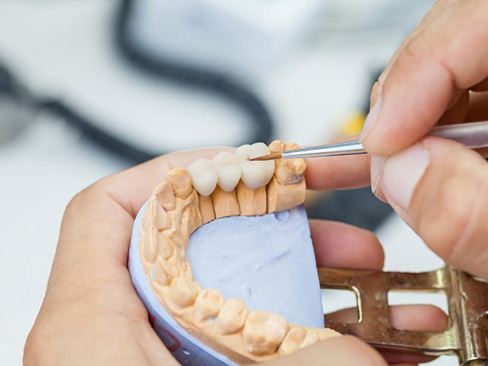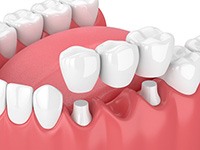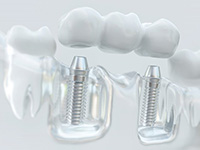
Dental Bridges – Dallas, TX
Replacing Missing Teeth to Complete Your Smile
Losing one or several of your teeth can make daily oral habits quite challenging, such as eating comfortably and speaking clearly. The good news is that our team can provide a wide range of tooth replacement solutions to help you regain your complete smile, including personalized and lifelike dental bridges. Keep reading to learn more about these durable and long-lasting prosthetics or give us a call today to schedule your consultation!

Why Choose Midtown Family Dentistry of Dallas for Dental Bridges?
- Natural-Looking & Metal-Free Materials
- Completely Customized Results
- Professional & Caring Dental Team
What Is a Dental Bridge?

A dental bridge is a custom prosthetic that’s designed to replace a single tooth or a few missing teeth in a row. In most cases, a bridge can help replace one to three teeth. This prosthetic generally consists of two dental crowns that are connected by a certain number of artificial teeth, or pontics. The two ends will be supported by existing natural healthy teeth on either side of the gap in your smile (or dental implants if that’s your chosen option). Your new teeth will be constructed out of durable, tooth-colored materials.
Types of Dental Bridges

Dental bridges can come in all shapes and sizes, which mostly depend on the patient and the location and number of missing teeth they have. Here are the two kinds of prosthetics our team can provide:
Traditional Dental Bridge

A traditional dental bridge is typically designed to help replace a row of missing teeth by using the healthy existing ones on either side of the gap. These are known as “abutment teeth” and will generally need to be altered to make room for the two dental crowns as well as the pontics. This option does take a few dental visits to complete, and it does come with a lower cost.
Implant Bridge

If you don’t have healthy adjacent teeth, then our team may recommend providing you with implant dental bridges. These prosthetics will instead be anchored directly to your jawbone via dental implants, which can serve exactly like natural tooth roots and offer long-lasting results. Not only will your prosthetic have incredible stability, but you might even be able to replace more than three teeth in a row due to the metal posts being fused to your bone tissue.
The Benefits of Getting a Dental Bridge

By replacing missing teeth with a dental bridge, you’ll be able to expect to enjoy a wide range of advantages to your smile, including:
- Greater chewing ability
- Prevention of dental shifting
- Reduced risk of oral health problems
- Improved speech and confidence
- Cost-effective tooth replacement solution
- Results that can last a decade or so (or 30+ years with implant bridges)
Dental Bridges FAQs
Can You Take a Dental Bridge Out?
No, and we don’t recommend attempting to do so! Your dental bridge will be a “permanent” fixture in your mouth. By “permanent,” we mean that while you may have to replace it further down the road, only a dentist can safely remove this restoration.
If you need your dental bridge repaired, replaced, or removed for a different reason, give us a call and let us know. We’ll help you schedule an appointment with our team!
Is Getting a Dental Bridge Painful?
Most patients find the topical anesthetic enough to completely numb the treatment area. In fact, dental bridges often help patients avoid discomfort by preventing teeth from shifting and protecting exposed dental gap from debris and stimulus.
That said, your teeth might be sore and sensitive for a few days after your bridge placement. This is normal, and we would only be concerned if you start experiencing severe pain or if it doesn’t go away. Then it’s best to call us for an emergency appointment!
On one final note, know that we do provide sedation dentistry for patients with dental anxiety or who have trouble sitting still for long procedures. Let us know if you think you would benefit from this accommodation, and we’d be happy to meet with you to discuss how we can best ensure your comfort.
Is a Partial Denture the Same as a Bridge?
They are not, although it’s easy to confuse the two. The main difference between a partial denture and a dental bridge is that a bridge restores consecutive gaps, while a partial denture can replace missing teeth at multiple different points along an arch.
A partial denture, unlike a bridge, can also be removed at the patient’s leisure. Depending on how you look at it, this can make it seem more or less simple to clean and maintain. Either way, we’ll be sure to go over your restoration options and help you choose a treatment you’ll be satisfied with.
How Many Teeth Can a Dental Bridge Replace?
Dental bridges are most often used to restore one or two smile gaps but can replace up to four missing teeth – as long as they’re all in a row, of course.
Something you should know about these longer bridges is that they can be less stable. The whole row would still be supported by only two teeth, after all. Depending on the case, we might recommend an implant bridge in this sort of situation. The implants help anchor the restoration and are strong enough to reduce the risk of treatment complications.
How Long Should a Dental Bridge Last?
The average timeframe for dental bridges in Dallas is between 5 and 15 years. The lifespan of your teeth will ultimately depend on a few factors, such as:
- Which materials were used to create your new bridge?
- Where is the bridge located inside your mouth?
- How well are you taking care of your artificial teeth?
Our team uses only the highest-quality materials when crafting these kinds of prosthetics, and we will make sure you understand that bridges placed toward the back of the mouth are more likely to wear down quickly. The reason is that they sustain more chewing force, so they may need to be replaced much sooner than one that sits at the front of your mouth.
You’ll also want to make sure you are properly cleaning and maintaining your oral health and hygiene (i.e., brushing, flossing, rinsing, keeping six-month checkups and cleanings, etc.) if you want your bridge to last longer.
Can Dental Bridges Be Whitened?
No, a dental bridge cannot be whitened because they are not porous like natural teeth. The materials used to create these artificial teeth cannot absorb the bleaching agents that are used to brighten regular enamel. This is why your bridge will stay the same color. If you want to reduce the chances of it becoming discolored over time, take proper care of it by staying on top of your oral hygiene routine and limiting your consumption of stain-causing foods and beverages.
Also, if you’re worried it might stand out from your other teeth over time, ask our team about having your teeth whitened before receiving your dental bridge. This will ensure that it matches your natural teeth once it’s put into place.
Can Dental Bridges Get Cavities?
The teeth that consist of your dental bridge cannot develop cavities; however, those that exist underneath (anchoring abutment teeth) can still be vulnerable. When eating, food debris can become trapped underneath in the space where your crowns meet your natural teeth, as well as beneath the pontics that sit atop your gums.
If you lack regular oral hygiene, you may notice that cavities form, or your gums become irritated. This is why it’s essential to make sure you’re cleaning properly above and below your dental bridge so that bacteria do not form within the cracks (especially if your prosthetic is nearing the end of its lifespan).